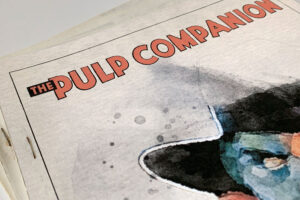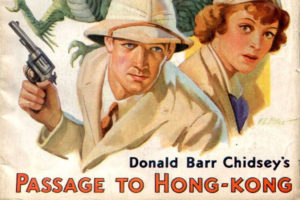An illustrator recalls the struggles of the contributors and publishers of the Canadian pulp magazines during World War II.
Fanzine flashback
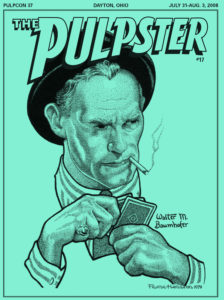
This article appeared in The Pulpster (No. 17, 2008).
One should bear in mind that during this period in Canada — 1941 to 1943 — there was a ban on importing magazines of the pulp and comic book variety from the United States. Publications of the calibre of The Saturday Evening Post, Ladies Home Journal, Colliers, and other “slicks” of this sort were, however, allowed inside the country.
I believe it was instigated as a form of discrimination against what was generally considered “trashy,” low-grade literature that was, for the most part, divorced from the war effort.
With the complete cessation of all pulps and comic magazines from the States, newsstands in Canada became virtually denuded. To fill this void many Canadian publishers and would-be publishers jumped onto the proverbial bandwagon.
One of the first companies to surface with this type of publishing was a Toronto company known as Ever-Ready Publishers. Their output consisted of several pulps in the mystery, horror, and western categories.
One of their initial efforts, Daring Detective (May 1941) sported a red-and-black line cover (as opposed to process color) executed by someone known as “Del’Orah.”
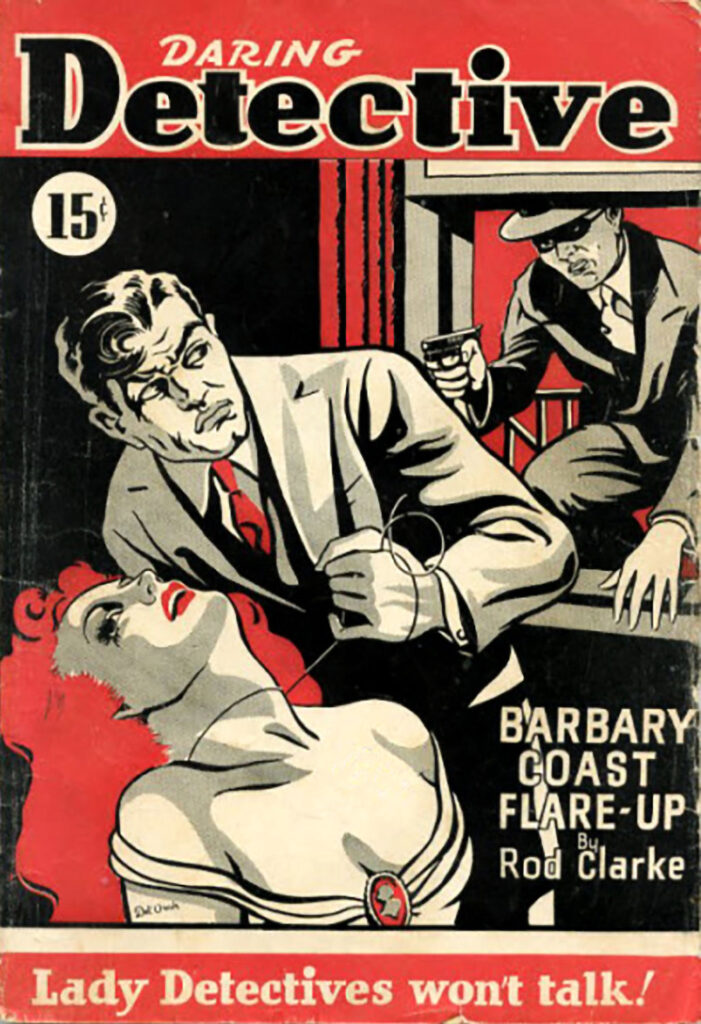 This was the work of one of Canada’s real “hack” illustrators of the period by the name of Harold Bennett. Del’Orah being Harold, more or less, spelled backwards!
This was the work of one of Canada’s real “hack” illustrators of the period by the name of Harold Bennett. Del’Orah being Harold, more or less, spelled backwards!
Where Ever-Ready got the stories for their magazines, or whether they had any remote connection with American publishers, I do not know. The material appearing in their Uncanny Tales would suggest that much was reprinted from the States. The interior artwork, in black and white, was for the most part lifted straight from magazines that had been previously printed in the United States.
For reasons that were never made very clear to me, I was solicited to do some of the interior illustrations in their magazines. What I could not understand was why some of the stories required new (Canadian) artwork, while others relied on existing (American) illustrations. Was it done as some sort of justification to warrant a “Canadian produced” publication?
Nevertheless, with the advent of Daring Detective with three of my illustrations and Dynamic Western (July 1941) with seven, I made an inauspicious debut in the pulp field on the newsstands of Canada. Dynamic Western, I recall, had a full-color process cover by Harold Bennett using another of his aliases, Walter Leslie.
Ever-Ready’s Uncanny Tales was Canada’s answer to Weird Tales.
It was, through a chance meeting, with one of the contributing authors to Uncanny, Thomas P. Kelley, that my work was inadvertently brought to the attention of Alec Valentine, the editor/publisher of Ever-Ready.
Thomas P. Kelley who mixed a pugilistic career with writing had been successful in selling material to Weird Tales in the States. His story “I Found Cleopatra” (which had appeared in Weird) was now running in installments in Uncanny. It was primarily due to his unauthorized request to me to produce a cover for yet another of his stories for Uncanny that had me submit my work to Ever-Ready even though it had not been commissioned by the editor.
While Ever-Ready never bought or used the cover I did for Thomas P. Kelley (it showed an undersea King Kong, I remember), it did become my calling card, as it were, and it was not long before I was being utilized in their other publications.
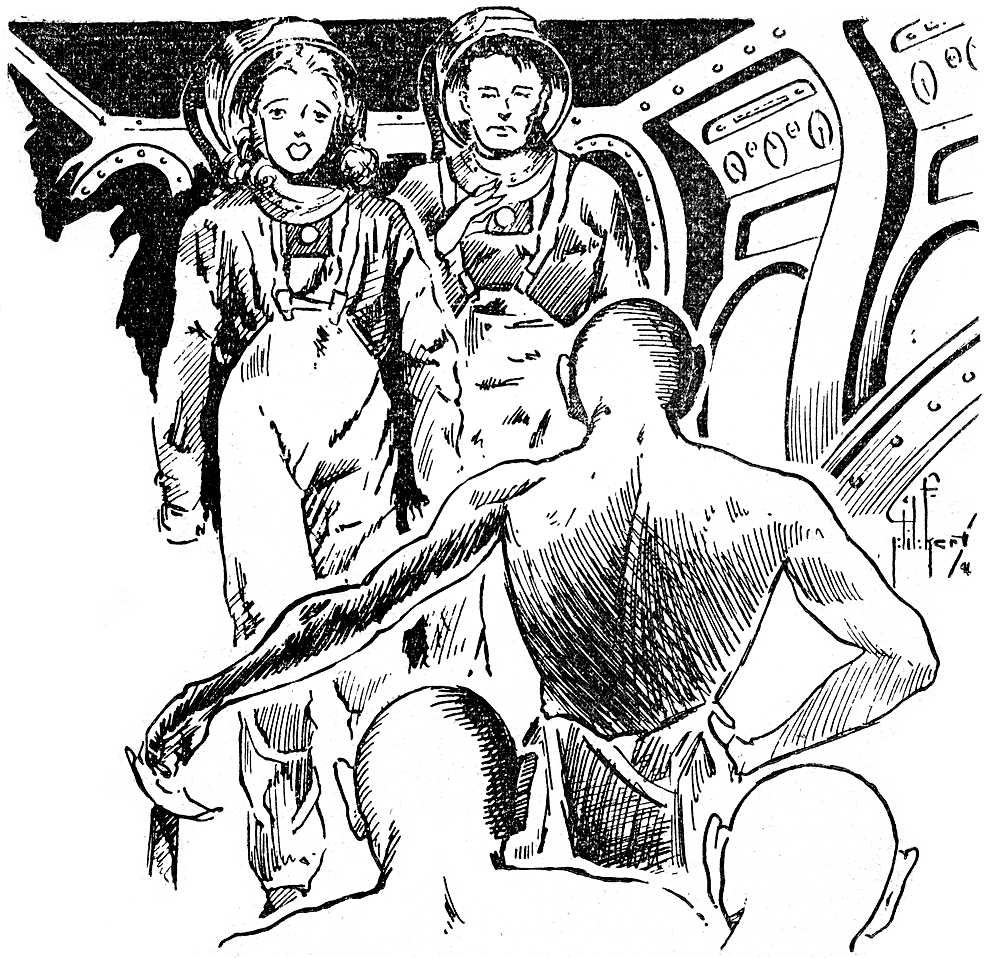
Though I later contributed to several issues of Uncanny, I never did illustrate any of Kelley’s works in that magazine. In the September 1941 issue, I did work for “Cycles of An Ego” by C. Lamont Turner, “Doomed by the Dead” by Allen Lake, and “The Mine of the Moon Men” by Callan Edmunds. It was in this edition that the final installment of Kelley’s “I Found Cleopatra” appeared.
The following month, October 1941, Uncanny carried another of my interiors for a story by Niel Parrin called “Doctors of Evil,” and by January 1942, I had three more illustrations appear: “Lure of the Lily” by Robert W. Lowndes; “Doctor of Doodling” by Frederick Traff; and “The Stolen God” by Denis Plimmer. By now, however, I owed my allegiance to a rival publisher so I thinly disguised my name by signing my work “Kerthil.”
We were, you see, all relatively unknown as pulp illustrators, even in Canada, mainly because up until now, most, if not all the artwork in this field was done in the States. Of course, we all hoped and trusted we would build a reputation on our own and that some American editor would see our work and take a liking to it. Often, however, as in the case of Harold Bennett and myself, one was more likely to be either employed or under contract to a publisher who did not always look favorably on those who worked for their rivals in the business, thus our coyly hidden names and aliases on the work. We wanted to take the credit for possible publicity, but we didn’t want to be audaciously conspicuous about it.
Around this time, Thomas P. Kelley approached me on yet another project. He wanted me to work on still another Weird Tales — this one to be known as Eerie Tales, published by the C.K. Publishing Co. (C.K. stood for Coinok, the gentleman who was backing Kelley.) In this magazine, Kelley would presumably edit and write most, if not all, of the stories.
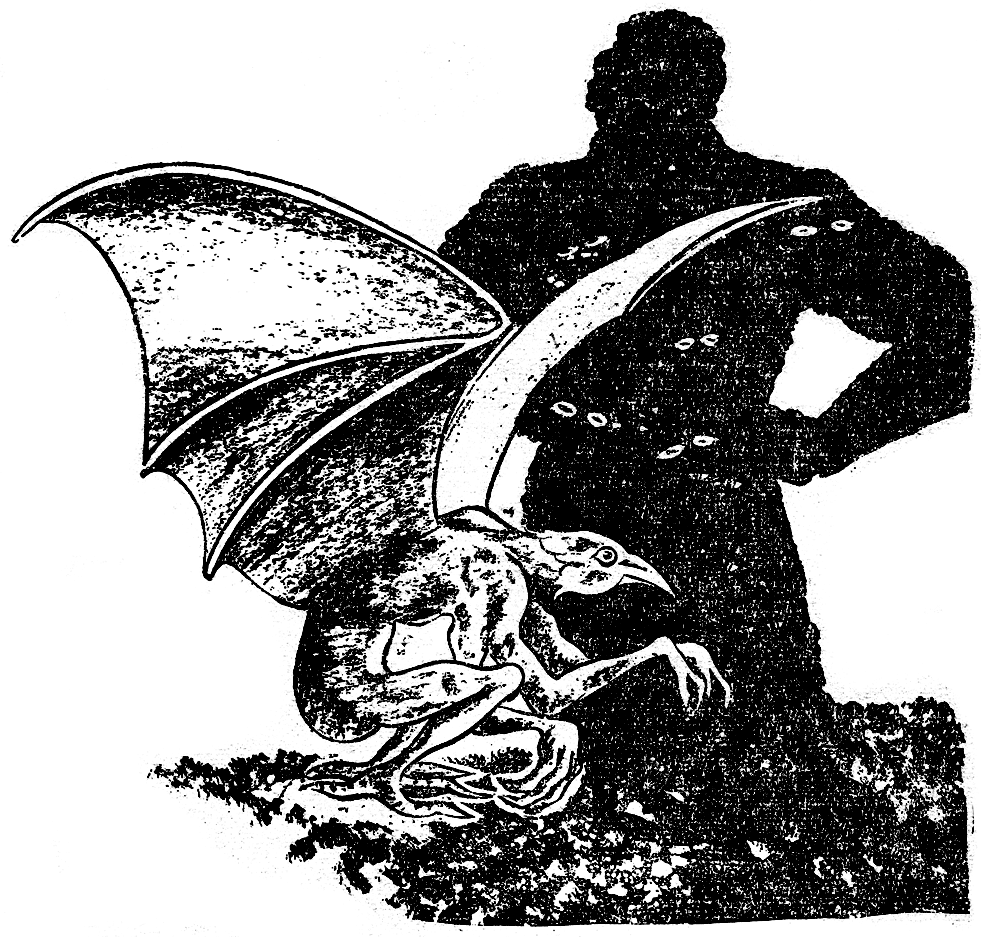
There was happily, just one issue of Eerie Tales (July 1941). True, most of the stories were works by Kelley under a myriad of nom-de-plumes. This in itself was a limiting factor in its success. [It is amusing to note, according to Hilkert, that one of the “authors” in Eerie Tales — Ethel G. Preszcator — was Kelley’s wife, “a rather striking redhead who had been a showgirl in burlesque, I think.” – Ed.]
My cover for that issue, the first issue I had painted for the pulp magazines was, to put it mildly, an abomination, due in part to incompetent photo-engraving. (By now, the draft was taking experienced draftsmen from all fields.) Kelley, I recall, insisted on having himself billed as “The Horror Man” on it. Thus ended the ill-fated Eerie Tales with its first and last issue!
For a period of time I became affiliated with Superior Magazines where I worked with Harold Bennett. Together we produced all the covers for their detective, Western, confessions, and science-fiction publications. Among some of the titles I did cover work for, while there, were Sure-Fire Detective, National Sports, and an oversized 8-1/2- by 11-inch effort called, quite simply, Science Fiction.
This latter magazine, edited by William Brown-Forbes, owed some remote and distant roots to Columbia Publications’ two science-fiction magazines being edited by Robert W. Lowndes at that time. Possibly because of my work on Science Fiction or my work on Uncanny (I had already illustrated Lowndes’ story “Lure of the Lily”) I was given several assignments for these New York-based publications by Robert W. Lowndes.
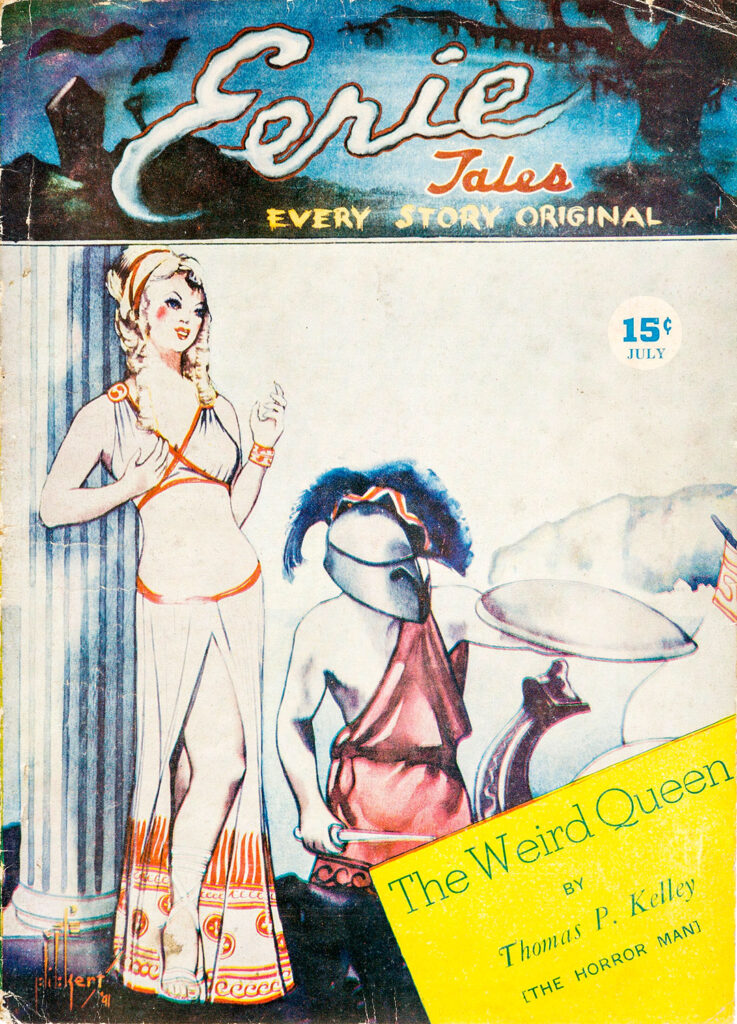 Subsequently, I had work appear in Science Fiction Quarterly (Fall 1942, #8) for Bob Tucker’s “Gentlemen — the Queen,” and in Future Fantasy & Science Fiction (December 1942) for a story by Henry Andrew Ackermann, titled “Fanatics of Mercury.”
Subsequently, I had work appear in Science Fiction Quarterly (Fall 1942, #8) for Bob Tucker’s “Gentlemen — the Queen,” and in Future Fantasy & Science Fiction (December 1942) for a story by Henry Andrew Ackermann, titled “Fanatics of Mercury.”
Pearl Harbor was by now a thing of the past. Both Canada and the States were involved in a common cause. Having being born in Ohio and an American citizen, I had until now, successfully avoided the Canadian draft — a situation that promised to become more difficult as time went on.
By now, several American pulp firms had established Canadian publishing outlets. Popular Publications had brought over their line and were printing Adventure, among other titles they owned. Apparently all stories in these Canadian editions were from their American counterparts but re-set in type and printed by Canadian printers on Canadian papers. Curiously, though the stories were by American authors, the illustrations and covers were executed by Canada-based artists!
Popular Publications used Edmond Good for much of their cover work. Ed was later to go to Chicago and take over the daily strip Scorchy Smith when its creator entered the service and was killed in action. Ed Good had previously worked on comics in Canada for Bell Features, writing and drawing Rex Baxter. I had met him at Bell when I was also there writing and creating a strip called The Wing. This strip may just have been the first superwoman to appear in comics in either Canada or the United States!
Late in 1942, Ace Magazines (Periodical House Inc.; A.A. Wyn, president) began printing their pulps in Toronto. This line of magazines consisted of four love stories, two detective, and one Western on a bi-monthly basis.
In the States, Norm Saunders had been doing their detective and Western covers. He was considered one of the top men in the pulp magazine cover field, and Ace was proud to have his services. In Canada, those who represented the Ace line wished to carry over this same “Norm Saunders look” as much as possible, and consequently went shopping for someone who could do a fair imitation of his work.
Just why they didn’t bring over from the States the cover plates of the Ace Magazines or even the original Norman Saunders cover paintings, I will never know.
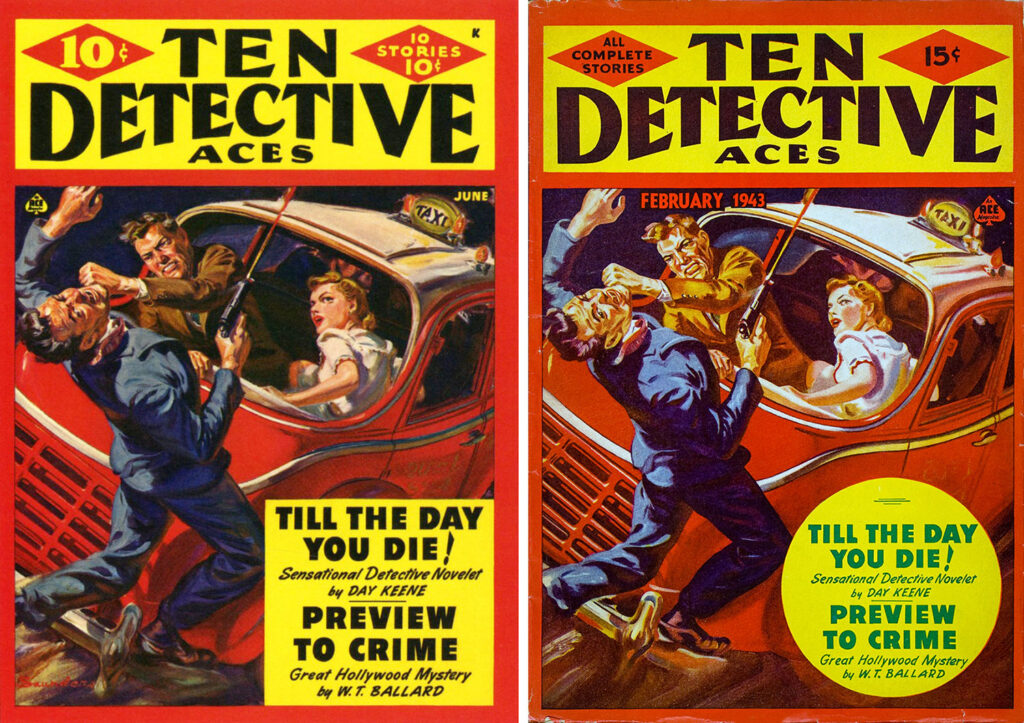
They didn’t, of course, and I got an informal contract to do all seven of their magazine covers including the four love story covers. Before I began to produce covers for them they had used photographs — movie stills — not altogether a very successful concept for a pulp magazine.
The challenge, in the beginning, to do a cover like Norm Saunders was a catalyst in itself. I had the highest regard and admiration for Norm Saunders’ work and I felt I could have had none better to pattern my work after. Though some may decry the loss of my “individuality,” I considered myself fortunate to be able to work in his style and technique professionally. I was only 23 at the time and despite the fact I had been moderately successful as an illustrator in Canada, I was nevertheless relatively inexperienced, especially in color work.
Soon, however, the pressure of turning out seven covers on a bi-monthly basis coupled with the low pay in the Canadian pulp field (I got only $50 a cover), combined with the immediate and pressing need for me to return with my family to the States for my military obligations, resulted, I am afraid, in little more than producing verbatim for Canada’s Ace pulps what Norm Saunders was doing for Ace in New York. This was, of course, what the Ace people in Canada wanted anyway!
I returned to Ohio early in 1943, before many of the covers I had painted in Canada were printed. In due time, I was inducted into the Army, where I served as a psychological warfare artist in Europe.
Following the war, I found the pulps in Canada were non-existent. Many magazines, I heard, could not get the necessary amount of paper to continue publication due to the low number of press runs they had. During the war, to justify publication and qualify for paper in Canada, magazines had to print a given number of issues. This, of course, sounded the death knell for most of the Canadian pulps.
And with the war over, the ban on American magazines coming into the country was lifted, and there was then no need to produce an more pulps in Canada anyway!
By now, the day of the pulp magazine was almost over even in the United States. This was regrettable, because in their heyday, they provided many opportunities to beginning authors like Erle Stanley Gardner and Max Brand, besides, of course, providing a training ground for scores of young artists and illustrators, such as yours truly.
About the author
John Hilkert (1919-94) had a short career as a pulp illustrator, working mostly for Canadian magazines, before returning to Ohio and being inducted into the U.S. Army in June 1943. He created The Wing, a female superhero (actually, Canada’s second one), and wrote and illustrated two stories featuring her for Joke Comics. Later in life, he and his wife, Pauline, operated a book store in California.


